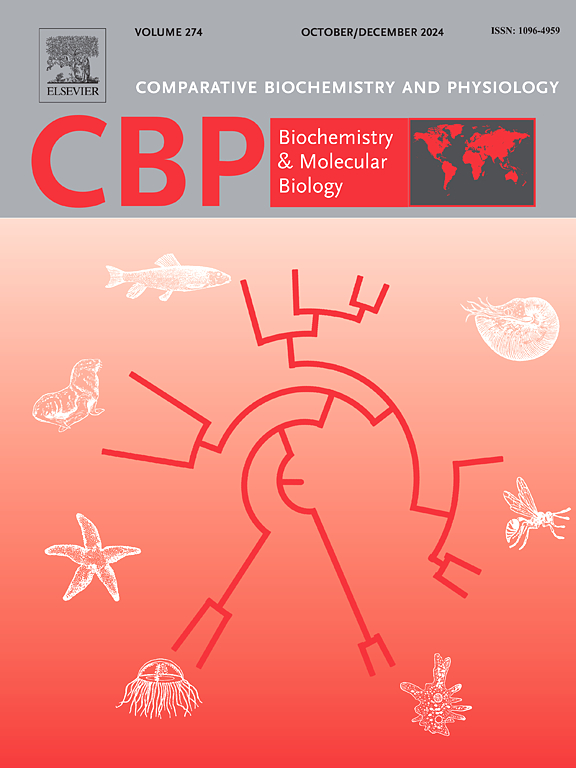糖原合成酶的调节变异导致长牡蛎和狐獴之间糖原含量的差异
IF 1.9
3区 生物学
Q4 BIOCHEMISTRY & MOLECULAR BIOLOGY
Comparative Biochemistry and Physiology B-Biochemistry & Molecular Biology
Pub Date : 2025-04-26
DOI:10.1016/j.cbpb.2025.111101
引用次数: 0
摘要
在海洋双壳类动物中,糖原是一种重要的能量来源,影响着生长、发育、配子体发生和生殖周期等重要生理过程。糖原合成酶(GYS)是调节糖原生物合成的关键酶,其表达模式与糖原的季节波动直接相关。本研究确定了长牡蛎和狐蝠种群中GYS基因转录调控区域内的遗传变异。两个关键的单核苷酸多态性位点SNP -792-G/T和SNP -60-T/C与糖原含量相关。GYS基因启动子的多态性导致了物种特异性转录结合活性的差异,与C. gigas相比,C. sikamea在核心区域表现出更高的活性。这个高度保守的启动子区域的多态性改变了转录调控元件对缺氧诱导因子1α (HIF-1α)和八聚体结合转录因子1 (OCT-1)的亲和力,从而影响GYS基因的表达水平。这些变化与狐獴和巨蝉种间糖原含量的差异有关。实验证据证实了转录因子与snp突变的启动子基序的特异性结合。这些snp代表了关键的物种特异性调控位点,可能作为选择高糖原含量牡蛎菌株的有价值的标记。我们的研究结果表明,GYS基因转录调控元件内的snp改变了转录因子OCT-1和HIF-1α的结合亲和力,从而在牡蛎的能量代谢中发挥关键作用。我们的研究为GYS基因的转录调控及其对糖原储存的贡献提供了新的见解。本文章由计算机程序翻译,如有差异,请以英文原文为准。

Regulatory variants of glycogen synthase contribute to differential glycogen content between Crassostrea gigas and C. sikamea
In marine bivalves, glycogen functions as a key energy source, influencing essential physiological processes such as growth, development, gametogenesis, and the reproductive cycle. Glycogen synthase (GYS), the key enzyme regulating glycogen biosynthesis, shows expression patterns directly correlated with seasonal glycogen fluctuations. This study identified genetic variations within the transcriptional regulatory region of the GYS gene in populations of Crassostrea gigas and C. sikamea. Two key single nucleotide polymorphism (SNP) sites, SNP -792-G/T and SNP -60-T/C, were identified to be associated with glycogen content. The polymorphisms in the GYS gene promoter result in species-specific differences in transcriptional binding activity, with C. sikamea showing higher activity in core region compared to C. gigas. Polymorphisms in this highly conserved promoter region alter the affinity of transcription regulatory elements for hypoxia-inducible factor 1 alpha (HIF-1α) and octamer-binding transcription factor 1 (OCT-1), thereby influencing GYS gene expression levels. These changes were related with interspecific differences in glycogen content between C. sikamea and C. gigas. Experimental evidence confirmed the specific binding of transcription factors to SNP-mutated promoter motifs. These SNPs represent critical species-specific regulatory sites and may serve as valuable markers for selecting oyster strains with high glycogen content. Our findings demonstrate that SNPs within the transcription regulatory elements of the GYS gene alter the binding affinity for transcription factors OCT-1 and HIF-1α, thereby playing a critical role in energy metabolism in oysters. Our study offers novel insights into the transcriptional regulation of the GYS gene and its contribution to glycogen storage.
求助全文
通过发布文献求助,成功后即可免费获取论文全文。
去求助
来源期刊
CiteScore
4.60
自引率
4.50%
发文量
77
审稿时长
22 days
期刊介绍:
Comparative Biochemistry & Physiology (CBP) publishes papers in comparative, environmental and evolutionary physiology.
Part B: Biochemical and Molecular Biology (CBPB), focuses on biochemical physiology, primarily bioenergetics/energy metabolism, cell biology, cellular stress responses, enzymology, intermediary metabolism, macromolecular structure and function, gene regulation, evolutionary genetics. Most studies focus on biochemical or molecular analyses that have clear ramifications for physiological processes.

 求助内容:
求助内容: 应助结果提醒方式:
应助结果提醒方式:


